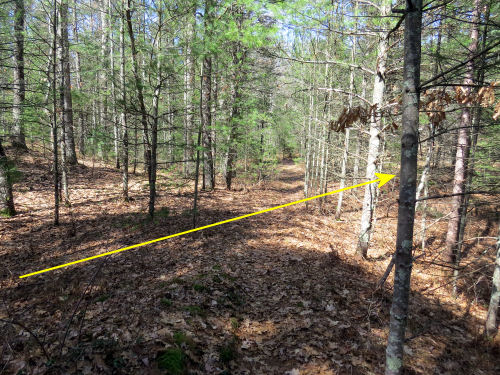I was out this afternoon refreshing blazes on the section of North Country Trail that I have adopted. Our Chapter's web site used to have a detailed set of pages that helped people know how to blaze, but things changed, and they are no longer there.
Maybe you are a little curious as to what I mean when I say "painting blazes." Maybe you have a piece of trail of your own and you need to know how to do this. So I'll tell you what I did today. I really need to get those instructional pages back up on the web somewhere. We had a ton of good info.
For starters, this is not like blazing the first time. That takes the short side of forever. This is a tiny bit easier because you can mostly repaint the same trees unless dead ones have fallen, understory has grown up that you don't want to remove, or you made bad choices the first time. (There are always some of those issues.)
The last time these blazes were touched up was (I think) six years ago. That's a long time. Too long, really, but because I did the job well in the first place, most of them weren't too bad. Here's one of the old ones. You can see that it's faded, and starting to chip, but still in pretty good shape.

Since this is the 101 course, I'll pretend I had to start from scratch. The secret of selecting trees to paint is that blazes should not be spaced according to a measured distance, but by sight lines. Here's a repeat of a picture from the other day.

When you reach one blaze on the trail, you should be able to see one more- like where the yellow arrow is pointing. Sometimes you'll see two, depending on how the trees have arranged themselves, but you don't want to see a whole string of them like Christmas tree lights. Choosing the trees to blaze is a time-intensive process. If you don't have two people you will do a LOT of walking back and forth to choose the correct tree.
Choose live trees unless there is really nothing other than a dead one. Just know that the dead one will probably fall down in a year or so, and then you'll have to pick another tree anyway.
Some species of trees are better than others. Red pine are some of the worst. However, there's a lot of planted red pine in the Manistee National Forest, so it's often the only choice. This is a six-year-old blaze on red pine that has held up this well only because it was prepped properly in the first place.

We've learned that you can scrape it down enough to make the blazes last well. And this brings me to my next point.
The bark should always be scraped and/or cleaned. Older trees need serious scraping. I like this marine scraper.

Some people like a hatchet, some a different kind of paint scraper. You want to take off all that loose outer bark and get right down to something solid that won't flake off. Here's a scraped red pine. You can see some blue, because that's where the old blaze was, but I rescraped it today because the bark loosens as the tree grows. You can see I've taken a lot off without hurting the tree a bit. Then I wipe it with a hand or rag to knock off any loose bits.

You don't want to nick the inner bark so that the tree begins to ooze sap. So on a smooth white pine or young maple, you probably shouldn't even use a tool. But you do want to knock off dust, lichen, and "stuff." A good rub with a rag is usually enough on these kinds of trees. They take nice smooth blazes that look terrific! But I don't have many of those easy trees on my section.
Now we are finally at the actual painting. The official North Country paint is Nelson Blue. Nelson is the company that makes it. This is paint that's formulated specifically for use on trees. It's oil based, and a real mess to work with, but it holds up well.
Here's that same red pine, with a nice fresh 2x6" blaze. Square corners, filled in well. Don't skimp on the paint. Stuff it into cracks in the bark.

I did about a half mile today, working on my own. This activity kills my shoulder, so when my arm starts to go numb, I have to quit.
All those instructional web pages are on one of my hard drives. I really need to make them available. I'll add a link here when I do that.
All together, I probably walked 6 miles (because I had to walk to the half mile I blazed), which makes the Hike 100 Challenge for 2020 at 59 miles.
In other news: I wrote some in The Lonely Donkey this morning, and then did the blazing. I still have at least a mile to go.
North Country Trail, Lake County, MI. Freesoil TH north to FR 5514 and back with numerous back-and-forth trips











































